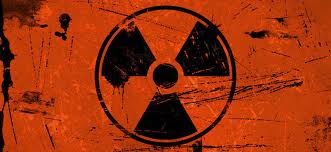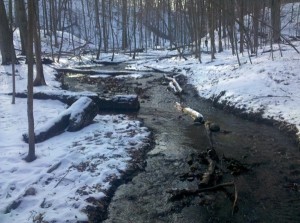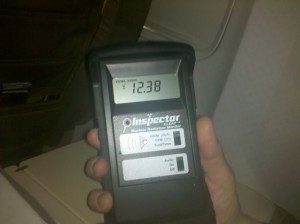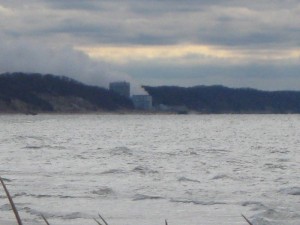By Michael Collins
EnviroReporter
Home for the holidays takes on a whole new glow when flying for the first time through Fukushima fallout to our family in Michigan.
Packing gets peculiar and precise. Inspector Alert nuclear radiation monitor – check. N-95 approved valved respirators to wear during flight – check. Apple pectin – check. Miniature lab to collect samples in a part of the country hammered by high fallout in rain, sleet and snow since March 11, 2012 – check. One pissed off newlywed wife having to endure this nightmare in a country of oblivious people now being forced to wear an N95-rated respirator on the plane because of her enviroreporter husband – check.

This was first time Denise Anne and I had flown since the triple meltdowns – now melt-throughs – had begun spewing astronomical amounts of radioactive goo into the air and ocean and across lands from Japan to Europe. For months, the readings of high radiation have rolled in from across the country where places like St. Louis have been irradiated by rainfall repeatedly over 170 times normal background radiation.
Other areas reporting in to Radiation Station Central, the monitoring assemblage created March 15 to show folks 24/7 radiation readings in the Los Angeles Basin, have sampled and tested rain and snow finding it dozens of times over background. Courtesy of the jet stream pipeline from Fukushima to North America, places like Toronto, Utah, Arizona, North Carolina, Virginia and the Pacific Northwest have all seen high levels of ionizing precipitation.
Anything three times background and above is considered “significantly” above normal according to the California Envirnomental Protection Agency. Triple background is also the tipping point for the California Highway Patrol, according to an official Nevada radiation report obtained by EnviroReporter.com. Anything above thrice background becomes a hazardous materials case for the CHP.
It was with no small amount of trepidation that we traveled to Michigan to be with our family. The thought that the cyrstalline white fluffy snows that make Michigan so charming during the holidays could be infused with cesium-137 and strontium-90 was horrifying.
What we found over our ten-day holiday confirmed that the Midwest was indeed getting pelted by high radiation but in ways we had not anticipated. Places that we thought would be impacted by fallout turned out to be rad-free while others were even hotter than we thought. Even with knowledge and experise, much gained through conducting over 1,500 radiation tests of rain, fog, food and drink since Radiation Station started March 15, we were still emotionally affected by testing hyper-hot rain falling on the family homestead.
Hot rain and snow were an acceptable risk. Flying through fallout was another matter entirely which we found to be much hotter than even what the manufacturers of our radiation monitor have measured pre-Fukushima.
Not surprisingly, no one aboard the aircraft we boarded at LAX December 23 was wearing a mask to interdict hot particles in fallout from the triple meltdown and burning of 550,000 tons of radioactive debris in Tokyo incinerators. No one even in first class had any protection on not only from the airborne radiation that is circling the northern half of the globe, but from the volatile organic compounds and low-level fumes airing the jet cabin as well as the recirculating viruses from hundreds of passengers some of whom were coughing and sneezing.
We decided to grin and breathe it to get to our Midwest homeland but not by holding our breath. Though worried that we would alarm crew and passengers by donning 3M 8511 particulate respirators N95, wearing the masks was a must since it would afford us the only prevention possible against the trillions of becquerels of ionizing radiation spewing into the atmosphere for over nine months. Our concerns were unfounded, however, as no one thought twice about the masks which we removed when eating our meals and going to the restroom.
While the respirators aren’t 100% effective against inhaling fallout – and can offer no protection against gamma radiation man made or otherwise – they certainly reduce the amount of non-filtered air intake to nearly zero. Radiation bioaccumulation can be greatly reduced by wearing N95-rated masks regardless, making their use essential when flying through Fukushima fallout now mostly confined to the Northern Hemisphere. Even though we were and are a tiny percentage of the 800 million passengers who take to the skies annually worldwide who wear respirators, we were glad we had even before we landed and tested the masks for any hot particles they may have prevented us from breathing.
As the airliner crossed over the Colorado River into Arizona, we were completing our first ten-minute average using one of our Inspector Alert nuclear radiation monitors which can detect alpha, beta, gamma and x-ray radiation. The Inspector is made by Tennessee-based SE International, Inc. (which advertises on EnviroReporter.com through Google AdSense which controls who advertises on the website in some of the ads). Since 1979, this company has expanded in size and distribution as the worldwide demand for radiation detectors has mushroomed.
The captain came on the loudspeaker and announced that we were at 28,000 feet heading up to 38,000 feet. SE International’s “Radiation Basics” page says “When you fly in an air plane at 30,000 feet your rate meter is getting 200 CPM [Counts Per Minute] for anywhere between 2 to 5 hours.”
Our reading was 1,035 CPM which was over five times higher. Two hours later we took another ten-minute average approaching the Missouri River north of St. Charles, Missouri – 1,238 CPM or over 36 times the background in the jet at the terminal. Descending into Chicago the count was 586.2 CPM or 17.40 times previous background in the jet.
Once in our southwest Michigan lodgings, Denise Anne and I tested the two masks we had worn after taking a new background. One respirator was 44% above normal and the other 69% higher than background.
The masks weren’t the only thing that was hot. Global warming was the likely culprit behind the unusually snow-free winter southwestern Michigan was having. No one could remember a time when there wasn’t snow on Christmas. We made good use of the mild weather and hiked the wilds of Michigan along the Kalamazoo River. Later that night, I tested a sample of the river and it came in 267% above background.
That high-sounding number may not totally be the result of any fallout from the Fukushima meltdowns. In July 2010, an oil pipeline busted open letting 3.8 million liters of petroleum to gush into the river. Alberta-based Enbridge Inc. is spending $700 million to clean up the goo having already sucked, scooped and captured 3.5 million liters.
The EPA says that petroleum waste products do contain small amounts of naturally-occurring radioactive materials like uranium, radium and thorium that could account for some of the radioactivity we detected. That seems unlikely though because of this wasn’t waste but instead heavy crude oil that had been spilled.
Snow finally came December 27 and we watched it blanket the family compound. The storm had originated out of the Gulf of Mexico and the radiation readings reflected it: backgrounds and sampling throughout the day and night showed no rise in radiation above background. While that fact is important in and of itself vis-a-vis radioactive fallout from Fukushima not being in a storm that didn’t come in on the jet stream, it was important for another. There was no presence of so-called “radon progeny” or the decay products of radon captured in precipitation that sometimes affect radiation readings.
The absence of radon progeny in this storm, and in a subsequent Michigan storm, suggested that the area we were in at that time was not impacted at all by these radioactive by-products. This point is important because meltdown deniers who routinely dismiss any fallout detection as radon daughter products, can’t explain away the fact that this snow had no additional radiation at all, let alone radon progeny. Another point is that when we actually did detect heightened radiation in Michigan rain, it was probably all the result of fallout and not these gaseous emissions that emanate from the soil in other parts of the country.
Knowing that the snow was normal made the appreciation of it all the more intense. It also provided a lovely backdrop for a journey to Lake Michigan to see the old stomping grounds and relieve memories of blueberries and beaches. It also was the perfect time to test the waters of Lake Michigan in picturesque South Haven Dec. 29.
Five miles south of the harbor town sits Palisades Nuclear Plant which we could see from the dunes by the dark choppy water. The 40 year old plant sits on 430 acres and has had a slew of recent problems. The reactor unexpectedly shut down Sept. 25, 2011 when a worker caused an arc in an electric panel.
“This resulted in a series of electrical issues that caused the plant to shut down and sent signals to multiple plant systems causing certain safety pumps to start and some safety valves to reposition,” said a news release.
This came on the heels of a leaking valve Sept. 16 and an Aug. 9 accident when a coupling that holds pipes together ruptured. A similar failure occurred in 2009 at the plant.
The Nuclear Regulatory Commission recently cited improper maintenance by workers that led to a May 10, 2011 shutdown of a water pump at Palisades reactor. The NRC downgraded the plant one notch on a scale of five Jan. 5 for the May incident and may further downgrade the nuclear reactor complex after review of the latest accidents and mishaps.
Palisades spent fuel rods sit outside in 21 16-foot-tall storage casks on concrete pads, each filled with 30 tons of rods even more radioactive than the ones operating in the core of the reactor. Palisades’operating license was renewed by the NRC in 2007 and is valid until 2031 when it will be 60 years old.
Farther down the coast we went to Warren Dunes and sampled more lake water. The park with its famous high and steep dunes is about five miles south of the Donald C. Cook Nuclear Generating Station. The facility has two reactors on Lake Michigan near Bridgman.
A fault in the main transformer Jan. 15, 2003 causes a fire torching the main generator and back-up turbines. No one died in the accident which cost $10 million. Both reactors shut down for two days in April 2003 because of an enormous intrusion of fish. Broken low-pressure turbine blades damaged the Unit One reactor main turbine and generator Sept. 20, 2008 causing intense turbine vibrations. Cook was able to keep Unit Two operable during the nearly catastrophic accident.
The $3.352 billion (in 2007 dollars) plant, also about the same age as Palisades to the north, was relicensed by the NRC Aug. 30, 2005. After originally being licensed for 40 years, Unit One’s operating license will now expire in 2034 with Unit Two’s expiration three years later.
Luckily, both water samples near Palisades and Cook nuclear plants registered normal. Our luck didn’t hold out for long, though, because a new jet stream-driven rain rolled across southwest Michigan the next day and with it came the highest radiation readings we’ve ever taken in a storm since the meltdowns began.
The Dec. 30 storm’s first sample taken tested at 561% of normal. The second sample was even hotter coming it at 6.5 times background. Fukushima had arrived in earnest.
On New Year’s Day a huge cold jet stream storm bore down on Kalamazoo as we prepared to fly back to Chicago and on to California. We were able to test the leading edge of the rain and several samples measured at background levels with no detection of radon progeny. This was the first indication of a jet stream storm not having Fukushima fallout that we knew of leading to more questions than answers about the how fallout is traveling across and landing on America. The only certainty is that the United States government isn’t doing any testing that we’re aware of for Fukushima fallout in rain and snow that is clearly coming down across the country.
Fallout in passenger jets is not being monitored either. That didn’t prevent us from checking it ourselves and the flight home was much hotter than the trip to Michigan. This time, however, wearing the masks seemed natural like wearing a seat belt. And, once again, we were the only people on the plane who had donned respirator masks. We were glad we did once the radiation results started coming in as we ascended.
The first averaging yielded 1,161 CPM or 37.94 times previous background of the jet interior at gate in O’Hare International Airport in Chicago. The second ten-minute test came in at 1,480 CPM or 48.37 times background. The last 10-minute average was 1,740 CPM which was 56.86 times background and over 800% of what the manufacturer of the Inspector Alert nuclear radiation monitor said we should be detecting.
It was no surprise that when we tested our N95 masks at home, one came in at 200% of normal. Perhaps to welcome us back, rain drops in our garden were detected at over double background.
The New Year came in hot for Denise Anne and I but at least we were prepared. Unfortunately for millions of Americans, especially flight crews and frequent flyers, the sizzling season has just begun.

